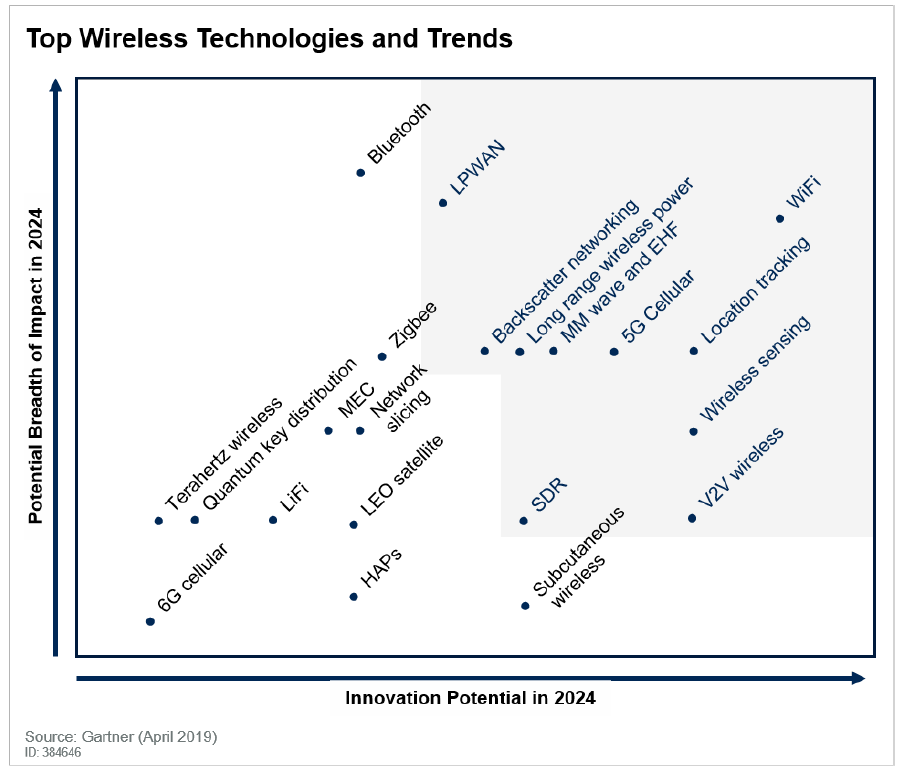By Gina Roos, editor-in-chief
Wireless technology will have a big impact on component development for emerging products and applications, including robots, drones, self-driving vehicles, and next-generation medical devices. It also means that product designers may need to beef up their skills over the next five years in new technology areas.
Tech trends for wireless communications are being driven by several underlying challenges and opportunities, according to market research firm Gartner Inc. These include spectrum congestion, longevity of wireless protocols, wireless security, system architectures such as edge computing, power consumption, and cost.
Here are 10 wireless technology trends expected to play a big role over the next five years, according to a new report from Gartner, “The Top 10 Wireless Technologies and Trends That Will Drive Innovation.”

1. Wi-Fi
Wi-Fi will remain the primary high-performance networking technology for homes and offices through 2024. Case in point: Gartner expects over 1.5 billion Wi-Fi chips to be shipped in 2020. Wi-Fi will also find new roles such as in radar systems or as a component in two-factor authentication systems.
2. 5G cellular
Although 5G cellular systems are starting to be deployed in 2019 and 2020, a complete rollout with take five to eight years. The technology may supplement Wi-Fi as a more cost-effective option for high-speed data networking in large sites, such as ports, airports, and factories. One key advantage is its ultra-reliable low-latency communications, which has big potential in real-time critical control functions and communications such as vehicle-to-vehicle and drone applications.
3. Vehicle-to-everything (V2X) wireless
V2X wireless systems will enable conventional and self-driving cards to communicate with each other and with the road infrastructure. In addition to exchanging information and status data, V2X can provide a wide range of services, including safety capabilities, navigation support, driver information, and fuel saving. There are two main V2X technologies in 2019: dedicated short-range communications (DSRC) standard, based on Wi-Fi using the IEEE 802.11p standard, and cellular vehicle-to-everything (C-V2X).
4. Long-range wireless power
First-generation wireless power systems have not delivered the user experience that manufacturers expected. The need to place devices on a specific charger point is only slightly better than charging via cable, although there are several new technologies that can charge devices at ranges of up to 1 m or over a table or desk surface. The expectation is that long-range wireless power could eliminate power cables from desktop devices.
5. Low-power wide-area (LPWA) networks
LPWA networks provide power-efficient and low-bandwidth connectivity for IoT applications for long battery life. Current LPWA technologies include Narrowband IoT (NB-IoT), Long Term Evolution for Machines (LTE-M), LoRa, and Sigfox and typically support very large areas such as cities or countries. The low-cost modules are used by IoT manufacturers to enable small, low-cost, battery-powered devices such as sensors and trackers.
6. Wireless sensing
Wireless-sensing technology can be used in a variety of applications from medical diagnostics to smart homes. Wireless signals can be used for sensing purposes in applications such as an indoor radar system for robots and drones or virtual assistants to improve performance when multiple people are speaking in the same room.
7. Enhanced wireless location tracking
A key trend is for wireless communication systems to sense the locations of devices connected to them. High-precision tracking to about 1-m accuracy will be enabled by the upcoming IEEE 802.11az standard and is expected to be a feature of future 5G standards. Location sensing integrated with the core wireless network could provide several benefits such as lower hardware cost and power consumption, as well as improved performance and precision compared to other systems such as finger printing and inertial navigation.
8. Millimeter-wave wireless
Millimeter-wave wireless technology operates at frequencies in the range of 30 to 300 GHz, with wavelengths in the range of 1 to 10 mm. The technology can be used by wireless systems such as Wi-Fi and 5G for short-range, high-bandwidth communications. Key drivers include the need for more spectrum and higher bandwidth.
9. Backscatter networking
Backscatter-networking technology can send data with very low power consumption, targeting small networked devices. Backscatter networks operate by remodulating ambient wireless signals. Thus, it will be used in applications in which an area is saturated with wireless signals and there is a need for relatively simple IoT devices, such as sensors in smart homes and offices.
10. Software-defined radio (SDR)
SDR shifts the majority of the signal processing in a radio system away from chips and into software so that the radio can support more frequencies and protocols. Although the technology has been available for many years, it has never taken off because it’s more expensive than dedicated chips. Gartner expects SDR to grow in popularity as new protocols emerge. It will enable a device to support legacy protocols and add new protocols with a software upgrade.
Gartner will present more findings at the upcoming Gartner IT Symposium/Xpo 2019 conference.
Advertisement
Learn more about Electronic Products Magazine





